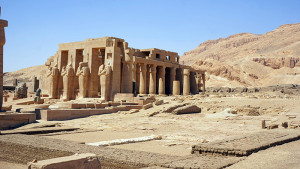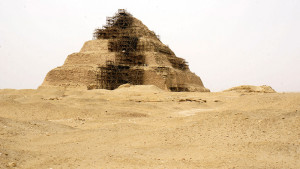The Finale: Exploring the wonders of the Red Sea, on land and water
The Red Sea holds incredible treasures above and below the surface. Sunken ships have become magical underwater gardens, and Jacques Cousteau’s futuristic submarine habitats remain for modern ‘aquanauts’. On land, the epic temples and pyramids of Egypt sit God-like in their timelessness, while in Sudan the scenes from ancient times live on in everyday life.

In the dunes and desert towns of Sudan, we had travelled back a thousand years. In my mind, this is one of the greatest wonders of all; a living history. We sailed out of Suakin past the wooden fishing dhows and row boats, bound for a different treasure; the SS Umbria.

Bombs in the darkness
Time bomb
In the summer of 1940, the Italian cargo ship Umbria had been steaming for Eritrea, laden with 360,000 bombs for its colonial troops. With the Second World War already underway, it was forced to anchor by the British off Port Sudan. Next morning, hearing over the radio that Italy had entered the war, the captain secretly ordered his ship to be scuttled, preventing its deadly cargo from falling into the hands of the Allies. More than eight thousand tonnes of explosives and war materials sank to the bottom… Fancy a dive?

SS Umbria
The massive hulk of the Umbria looms as we descend into the clear blue waters. We slip through the superstructure of the stern and glide through alleyways towards the open cargo holds. The wooden deck has rotted away, revealing the neatly stacked bombs; stacks and stacks of bombs! The ship settled on the reef at 60°, so this temperamental cargo is alarmingly angled. Bombs and detonator fuses lie strewn across the cargo hold. Serene columns of light fall through the portholes onto the equivalent of half a Hiroshima bomb; it’s eerie, and beautiful.
We continue along the encrusted corridors; a vivid mix of greens and blues, with nonchalant fish floating around, like extras on a set. It feels peculiar to be floating where men once walked and talked, generations ago. The corridor leads to the bridge, and as we linger in this wide room it almost feels like the Titanic, with its quiet history. There are so many dark rooms and corridors inviting exploration, down and down into the heart of this behemoth. It is an otherworldly playground, and I must return here!
Lighthouse for coffee
On our way north we stop at Sanganeb Reef, famous for its hammerhead sharks. We do a colourful wall dive, but the hammerheads remain illusive. The lighthouse makes up for it though, and after we climb down from the top (where a clear horizon reveals the curvature of the Earth), the friendly keepers welcome us for coffee. They are port officials who stay out here for two weeks and return to Port Sudan for six. The lighthouse is very relaxed; it is like their holiday home out on the sea. They spend their time chatting and smoking cigarettes, and welcoming the occasional visitors; mostly dive boats. Our coffee break is concluded by an enchanting call to prayer that resonates throughout the lighthouse.


The Urchin Inside Jacques Cousteau’s submarine hanger
The Life Aquatic
I was very excited to dive on Jacques Cousteau’s underwater research station at Sha’ab Rumi. In 1963, five of his Calypso crew lived for a month in the ‘Conshelf II’ submarine habitat. Part-funded by the oil industry, their role was to study the practicality of using undersea bases for the exploitation of the sea. As divers, of course, their interest was in the sea life and the potential for humans to live in such habitats in the future; Cousteau eventually cut his ties with oil and concentrated on conservation. The 1964 documentary of this experiment, ‘World Without Sun’, won an academy award; it is an amazing combination of an old Bond film and The Abyss, in real life.
The living quarters, nicknamed ‘the Starfish’, was removed, but the UFO-like submarine hangar, named ‘the Urchin’ for its shape, still sits there today on the edge of a drop-off.
Above water, Sha’ab Rumi tells nothing of the legend beneath. We anchor our dinghy near the narrow channel that Cousteau blasted through the coral. Swimming in the direction the habitat should be, I round a coral outcrop and the Urchin appears before me. Even with the regulator in mouth, I let out a “Woooow!”. It seems almost holy…
Slowly, we descend beneath the alien structure and rise up into its dome. There is a dim light cast by the portholes, but it is empty except for a small metal table, where a plump fish sits watching us. “Hello gentlemen…” he seems to say, “I’ve been expecting you”. He seems to fit into this whole fantasy.
The Urchin is still air-tight above the portholes, and we break through the silvery ceiling into a pocket of air; the old respiration of past divers. Ten meters down, we take off our regulators and laugh and whoop! What a place! But what a stench; I have to put my regulator back in to breathe some imported air.
The dives we did in Sudan were just spectacular, and totally unique; I never expected to dive on a space-station under the sea, nor on a mountain of dynamite. And being in Sudan, these sites are still undisturbed by mass tourism, though they are accessible by live-aboard from southern Egypt.


The RamesseumEgyptian at the Rameseum
Into Egypt
We put away the tanks, raised the dinghy, unfurled the sail and settled into the cockpit – our next port of call was 650km north. For more than a week we followed the coastal mountains and plains, waiting out the windiest days anchored in desolate bays. Wind alone is fine, but it builds up the waves and that is what becomes uncomfortable and dangerous. Finally, after sunset one night, we pulled into a marina in Marsa Alam, Egypt. What a luxury it is to simply step off the boat onto solid ground.
The real luxury of Marsa Alam was that there were other boats. It had just been me and the captain for 3 months, on many long passages and through obscure places without much of a common language. Being a social person I was craving simple friendship. I was amazed to see a UAE flag flying from the boat next to us! A couple of friendly Italians were delivering it from Muscat to Turkey. There was also an American family, who had three Royal Marine security personnel aboard for the Gulf of Aden. These guys were quite jealous to hear of our encounter with pirates; they wanted to see action. Instead they had to relax on a yacht for three weeks. The family had not touched land since leaving the Maldives, 18 days before. It seemed a shame they had rushed through such a unique part of the world, taking the risks but missing the rewards.
We enjoyed the simple pleasures of being back in civilisation; coffee shops, internet, new faces, and of course – amber nectar! A Spaniard docked next to us on a small boat, so we had him and the Italians aboard for a pasta evening, digging through the drinks cupboard for Zac’s mysterious liquids from around the world. They cooked the pasta and we supplied the merriment. Spontaneous boat parties are something I love most about the sailing life.
Nile Valley
Our friends set off and we took the opportunity to go and see Luxor. We drove through the rocky landscape until we met the Nile Valley, where a solid line of green ended the desert abruptly. Lush fields and palm trees explained Egypt’s ancient wealth, cultivating the world’s biggest oasis. I was thrilled to see the culture still alive. We had passed donkey caravans riding through the desert, and in the Nile oasis, beautifully robed Egyptians were driving donkey carts piled with sugar cane and grasses.

Egyptian Wedding
On the first night I ended up at an Egyptian wedding, invited by a cousin we’d met at lunch. Wandering through the narrow streets, a colourful marquee appeared, with all the neighbourhood in attendance. I sat with the men, smoking herbal shisha, with cheeky children crowding around. A sword fight was played out in traditional dance, and as it always seems to happen, I was called to join them. Surrounded by the children, I cut loose with my headdress; then I was given the sword, and the children were cleared from the arena. It was enchanting to watch, and though I didn’t do it any justice myself, it was great fun to swing a sword in combative dance!
To give the whole picture though, I was pestered for money by the children, and even some of the adults. This was quite a theme in Egypt, and though understandable, it definitely detracted from the country. Money always cheapens an experience, and it was really in contrast to Sudan, where even a beggar would not beg if you did not offer.
Something indisputable is the incredible wealth of ancient monuments. UNESCO World Heritage sites were sitting quietly by the roadsides, without a person in sight. We decided to investigate one, and we found ourselves alone, wandering beneath the immense hieroglyphed columns in a temple complex of Ramesses II. In the silence of the desert, it felt like we could be the first explorers to find these ruins. In fact, amongst the hieroglyphs were ornately chiselled graffiti of names from the 1800’s.
Another highlight was the Step Pyramid. At 4,600 years old, it is the oldest pyramid in Egypt, built 100 years before the Great Pyramids. It’s showing its age, and in 2011 an extensive restoration began. This is actually what made it so cool; we arrived to find wooden scaffolding all up the side, with jellabiya-clad Egyptians hauling stones up with ropes and pulleys. It was as if the pyramid was still being built!
There was a film crew up in the scaffolding, and I got into conversation with an Egyptian man who was working with them. “When it is finished, it will look like new” he said. I asked him if that was the right thing to do. “I believe, yes. If we leave it now, it will all turn to ashes and dust.” he said, looking up at the pyramid, “Then what do we have? Ashes, and dust.”

Under construction
Into the Pyramid
The Red Pyramid was Egypt’s first successful smooth-sided pyramid, the third attempt by Pharaoh Sneferu who built the infamous Bent Pyramid. It used to be a polished white, but as with the Great Pyramids, the limestone capstones were carted off in Medieval times for other buildings.
It’s one thing to see a pyramid, and it’s another to go inside. I was amazed to see steps leading up to an opening. No way! We climbed up the steps and found a tight shaft leading down and down into the heart of the tomb. After 200ft of stooped shuffling, the shaft opened up into a vaulted chamber; a cathedral inside a pyramid. ‘Woah’, I heard myself say, which echoed around the tiered ceiling. I followed a corridor into a second vaulted chamber, where steps had been built to access a shaft in the roof. This lead into the burial chamber; another 50ft high chasm with a million tonnes (literally) of rock above it. Just incredible.
And we were the only car in the car-park. Now is the time to go to Egypt.
Suez Canal
We continued up the coast, fighting the north winds and hiding in bays until we reached the port of Suez. There at the dock were the friendly boats of the Spaniard and Italians. It was great to see them again, tying it all together at the very end of the Red Sea. They left with their canal pilots early the next morning, bound for the Mediterranean.
The Suez Canal has no locks, so it isn’t particularly interesting; it’s 193km through dirty desert. There is a fortified wall along the northern shore, with regular garrisons, and periodical floating bridges ready ashore for troop movements.
Every boat requires a canal pilot, and it took us three days to go through – mostly spent waiting for the pilots! And they couldn’t speak English, so the Arabic proved useful again. I kept them happy with hummus, dates, foul maddems and sweet tea. Finally, we reached the Mediterranean waters of Port Said. The Indian Ocean, Arabian Sea, Gulf of Aden and Red Sea were all a crazy memory.
The End
From a trip that was set into motion while reading a thread about piracy in the Gulf of Aden, perhaps what transpired was to be expected… All I can really say is Wow. Run-ins with pirates, Yemeni rebels, helicopter gunships and Poseidon himself; not to mention the Bedouin of Sudan and the monuments of ancient Egypt. The Red Sea was especially amazing, and I’m already cooking up ways to get back.
Words + Photos by: Will Pardoe


